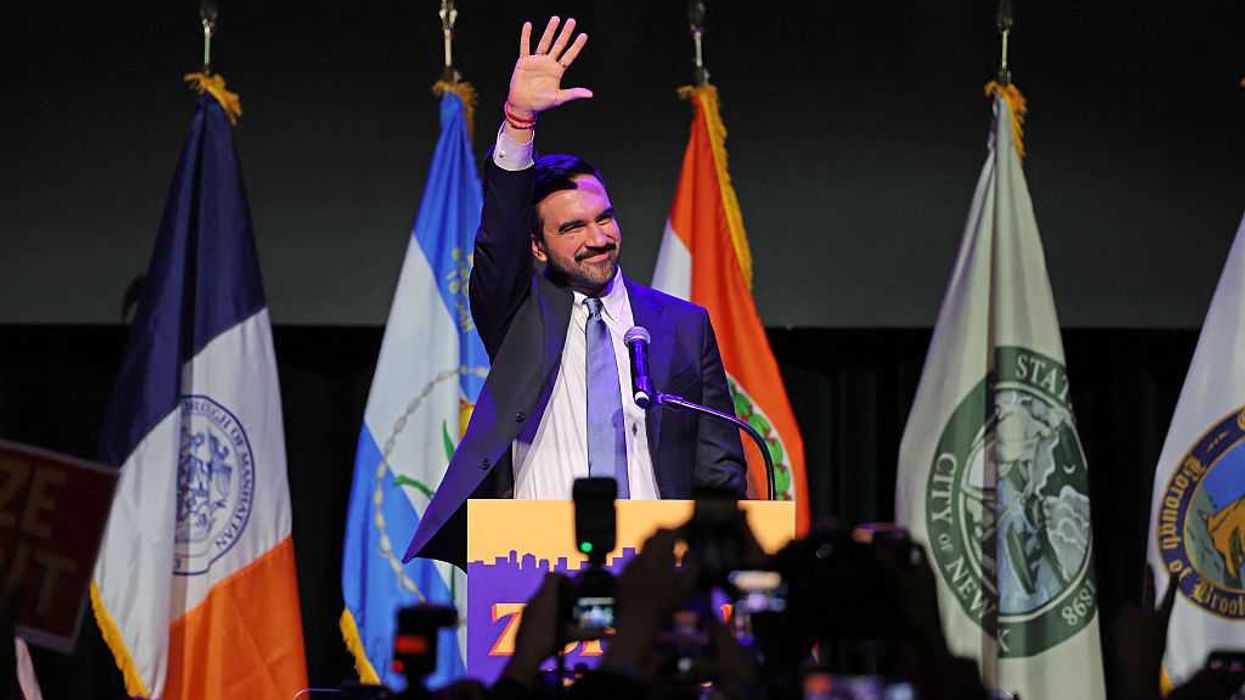Glenn has been following the story of jailed Marine Corps Sgt. Andrew Tahmooressi for a number of weeks now. Sgt. Tahmooressi has been in a Mexican prison since March 31 when Mexican federal officers arrested him for weapons possession. Tahmorressi and his mother Jill have maintained he took a wrong turn and crossed the southern border by mistake. The 25-year-old decorated war veteran and Florida native was in the process of relocating to San Diego for treatment of post-traumatic stress disorder. He had been in San Diego for 10 days when he ended up at the San Ysidro checkpoint.
After being arrested, Tahmooressi was originally held in Tijuana’s La Mesa Penitentiary, where he was placed in general population and his life was threatened. He was then moved to solitary confinement and shackled to a bed for nearly 30 days. Last week, Tahmorressi was moved to a maximum-security prison about 40 miles outside of Tijuana. He faces a sentence of six to 21 years in a Mexican prison for carrying his registered AR-15 rifle, .45-caliber pistol, and 12-gauge pump shotgun in his car across the border.
On radio this morning, Tahmooressi and his mother Jill both joined Glenn via phone to discuss what has transpired in the 63 days since he was first arrested. Tahmooressi candidly explained in his own words what happened the night he accidentally crossed the border and shared some new information about the conditions he has faced.
“It was 63 days ago that one of our heroes, one of the guys who has been fighting wars for us, was in San Diego… As the President makes a prisoner exchange – not a hostage release, a prisoner exchange – we have Sgt. Andrew Tahmooressi still in jail in Mexico,” Glenn said. “We have released 60,000 Mexicans onto the streets, and yet he is still sitting there, and nobody's even talking about it. For the first time, we have him on radio from his jail in Mexico, and his mom is also on the phone. She's kind of conference called us and put us together.”
To begin, Glenn asked Tahmooressi to explain what transpired when he reached the San Ysidro checkpoint.
In my own words, I was spending the day in Mexico, and I was hanging out, having some good food and walking around. I was thinking about staying the night in Mexico. I got a hotel in Mexico and decided that it wasn't a very nice hotel. It was dark and a little dirty, so I decided to go back to San Diego and be back with my friends cause I was missing my friends.
So I get a taxicab to the border, I cross the border, and I walk over to the parking lot where my truck is. I get in my truck, and I exit the parking lot. I make a left-hand turn followed by another left-hand turn that was – there was a road there that I was – I was – I got on that looked like it headed north back to San Diego, back to I-5 North. And I got on that road, and it happened that it turned, did a U-turn to the right, a swooping U-turn to the right and took me back on I-5 South heading to Mexico.
So I was driving nice and slow looking for a place to do a U-turn, but I couldn't find one. So that road took me maybe like another half mile down south to Mexico. And I get too the gate that was the Mexican border that I wasn't even sure if it was the Mexican border at the time. I figured it was, but I wasn't positive. And there was a lady sitting like three gates over to my left. And I stop at the gate and I wave to her to try to get her attention to tell her that I don't want to be in Mexico, but she waves me in like, you know, commanding me to go, go, come on, let's go.
So I follow my – her orders and I go. I did hesitate. I got a green light, the gate went up, I hesitated for like maybe 10, 15 seconds, cause I didn't want to be in Mexico, so once she ordered me in, there was three police officers, border police officers at a inspection table that are waving me in. So I drive to them. And put the car in park, and they ask me, ‘What is all this stuff that you have back here?’ I said I have all my stuff back here, clothes and things, and I have three guns. I told them immediately that I had three guns, and that I didn't want to be in Mexico. So I walk around the back of the truck with them, and I point out where my guns are, say I have two back here, a rifle and a shotgun and I have my pistol in the front on the passenger seat. So they go about looking at my guns, and they put the guns back in the truck, and they tell me that they're gonna help me out, that they're gonna take me back to the American border. They told me to wait maybe 30 to 45 minutes and that they were gonna get an escort vehicle for me to take me back to the border. They even – they asked me, they said, ‘You think it's gonna be okay with the American Border Patrol that I have three guns?’ And I said, ‘Yes, I think it's gonna be okay. I have permits for them, you know, I – I own these guns, so, yes, I think it's gonna be okay.’
So they moved my truck to another parking area, and they get my guns out at the truck, and they put 'em on the tailgate of my truck and they start getting all the ammunition out of 'em and all the ammunition out of my truck, and then they call on the radio, and I think what they said on the radio, which was in Spanish, that the – what the situation was that we have someone here with three guns, maybe they told them that I didn't want to be or not, I'm not sure, but there was a – shortly after that, there was a – a military captain that came over, and he took charge of the situation from there. And – and he – they took my truck from that one parking area into a fenced-in parking area that was screened in with black screen all around so no one could see what was going on. It was like a little hidden area, and – and then he – the military captain, he was very, like – he was, in a sense, I think he was trying to scare me a little bit. And – and of course I was nervous because I had – there was like 20 people there with military people with rifles, watching me and, you know, making sure that I wasn't gonna make any sudden movements or whatever, so I was – I was very afraid and nervous that they were gonna do something to me.
And I – you know, I think it was very – it was a very sketchy situation. There was something definitely not right there, and I think what it was was they were probably trying to get a bribe out of me, is what I think it was. What I'm pretty soon it was is that they were looking for a bribe, and they were trying to get me to sign some paperwork there that was all in Spanish, and there was no translator there to translate them. And I said, ‘No, I'm not gonna sign these paperwork – this paperwork. I don't understand them. I'm not signing them.’ And then they were saying after that point, they were saying, ‘Well, we're gonna take your truck. We're gonna take all your possessions. We're gonna take your guns.’ And then after they said that, that's when I called the 911 call, and I let 'em know. I said, ‘Hey, I'm in a bit of an emergency here, I accidentally drove into Mexico. And I didn't mean to be here, and I have three guns and they're trying to take my guns from me.’ So that's when that happened. And then – and then – and then – and then I was just more nervous, and I decided, you know, I'll sign the paperwork 'cause maybe that'll hopefully get me outta here, hopefully that will give 'em what they want and I could get out of here, and the lady who was translating who spoke broken English, she said that all the paperwork said was that I was in Mexico with three guns. I said okay, well, that's the truth, so I'll go ahead and I'll sign these papers. But shortly after the papers, they apprehended me and arrested me.
While Tahmooressi is still unsure of what the papers actually said, he explained the dangerous conditions he faced at Tijuana’s La Mesa Penitentiary.
“I was put in a cell, a small cell that was meant for six people. There was about 15 to 20 people in there, and there was all kinds of bad criminals in there… There was murderers in there and kidnappers and drug dealers and all these people,” he explained. “They threatened to rape me, they threatened to kill me, and I was very fearful. I was fearful to the point where my heart was pounding, and I couldn't have got a single word out if I had to yell for help.”
Fearing for his life, Tahmooressi attempted to escape, but he was apprehended and moved to solitary confinement where he was shackled to his bed.
I was just trying to get away, as far away as I could… [But] I was shot at by a lady on post. I surrendered… After that, you know, I got punished physically for maybe like 20 minutes to 30 minutes. And then after that I was stripped naked, and I was handcuffed – both my legs and my hands – around the post of a bunk bed there. I was there for maybe 12 hours, or maybe 10 hours, overnight, you know, shivering in the cold, naked. And then the next day they take me to another little cell by myself, and they cuff one of my legs to one wall and then they cuff my arm to the opposite wall about maybe two feet above my head. So I was there with my hand dangling above my head with… very minimum circulation going to my fingers there for… maybe 24 hours with no food, no water.
Then they take me off of the handcuffs, and… I was afraid that the prisoners were still gonna come and get me and that they were talking to the police officers, and that the police officers were gonna come and… torture me… and get information about my family. So I said I'm not gonna let them do that. There was a light bulb on… the ceiling, and I took this light bulb and I broke it and I stabbed myself in the neck cause I said, ‘I'm not gonna let them take my life. I'm gonna take my own life.’ That was my train of thought then, and I was there on my knees praying with blood pouring out of my neck, puddled on the floor.
Thankfully, thank God, the prisoners were outside of the door, and I think they heard the smash of the light bulb. And they came in, and I blacked out from there. Then I remember waking up on a bed in a room in the prison with IVs in my arms and with the doctor saying, ‘Andrew, come on, Andrew,’ trying to get me to wake up again. And thankfully I woke up again. They took me in an ambulance to a hospital, where they stitched me up, and then they took me back to the infirmary, the hospital in the prison, and then that's when they handcuffed all four of my limbs to the bed for a month.
TheBlaze has done a good deal of research into Tahmooressi and the events that unfolded before and after his arrest, but Glenn asked Tahmooressi if there is anything else that needs to be known.
“No, sir. God is my witness that I was not there doing any criminal activity. I had no intent on doing any harm or or breaking any laws or selling any guns or anything of that sort,” Tahmooressi said. “I've never been like that before in my life… I've always been a peaceful, loving man, and I don't break the law.”
The WhiteHouse.gov petition advocating for Tahmooressi’s release reached the necessary 100,000 signatures ahead of last Friday’s deadline, which means the Obama Administration, by law, is required to release an official statement. That statement will be the first from the Administration on the issue.
Glenn, meanwhile, asked his audience to continue to pray for Tahmooressi’s well being and safe return.
"Andrew, I'm going to ask for the audience to pray for you and pray that… you are encircled with truth. I admire you for not telling a lie,” Glenn concluded. “I will tell you that the only way God's powers work is if you're working with exactness, so tell the truth, the whole truth, and nothing but the truth, so help you God, and hopefully we will see his hand at work here. I'm disappointed in the hand of man, but never disappointed in the hand of God.”

 ANGELA WEISS / Contributor | Getty Images
ANGELA WEISS / Contributor | Getty Images
 Eric Lee / Stringer | Getty Images
Eric Lee / Stringer | Getty Images Andrew Harnik / Staff | Getty Images
Andrew Harnik / Staff | Getty Images